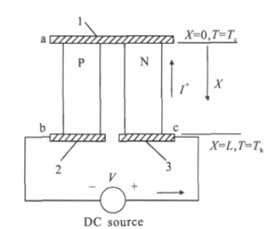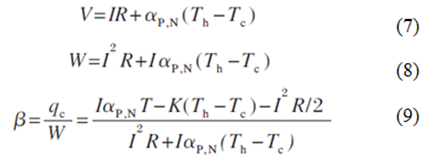When thermoelectric module is in the cooling mode, the heat of cooled device transfers into the cold end of
TEC and then based on thermoelectric effect, the heat is dissipated by the heat sink. According to the first law of thermodynamics, the cooling capacity is equal to the Peltire effect with heat conduction from the heat flow analysis of the single couple of TEC cold end:
Fig.1 Schematic of single thermocouple
Where,
qc is heat flow,
αP, N =
αP-
αN; the first item of (1) right side is Peltire effect; the second is heat conduction, and due to the X direction of figure 1, its value is negative. From (1) and (2), the general expression of cooling capacity can be obtained:
Similarly, the general expression of the heat dissipation capacity of the hot end is:
From (3) and (4), it shows that the cooling effet of TEC consists of three effects, namely, Fourier effect, Peltire effect and Joule effect. Peltre effect
αP, NT can make TEC endothermic in the cold end and exothermic in the hot end. Hot and cold end temperature difference of TEC can result in Fourier effect
K(
Th -
Tc )and Joule effect
I2R/2. However, it can’t be considered that the half of heat generated by Joule effect transfers to the cold end and the other half transfers to the hot side. For example, the dimensionless parameterζis introduced for (3) and (4), the followingformula can be obtained:
Whenζ=1,
qc =
IαP ,NTc+
IR,
qh =
IαP, NTh. At this point, the whole Joule heat will transfer to the cold end and there is only Peltier effect in the hot end. Because of the existence of Seebeck, the voltage, input power andrefrigeration coefficient of a couple respectively are:
The left characteristic analysis of TEC refrigeration cycle will be introduced in the next article.






